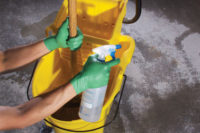
More than ten percent of the U.S. population suffers some degree of hearing impairment. Jackhammers, electric razors, crowded freeways, noisy offices, manufacturing equipment and stereo headsets are among the many culprits.
The hearing conservation section of OSHA's noise exposure standard (29 CFR 1910.95) requires that employers establish "a continuing effective hearing conservation program" if their facility generates high noise levels, that is, levels exceeding 85 decibels (dB) on an eight-hour time-weighted average (TWA). Also, employees must be trained in the potential hazards of noise exposure, and must be offered a choice of hearing protection devices.
It's estimated that more than nine million people are exposed to job-related noise levels above 85 dB, most of whom work in manufacturing and utilities. High noise levels are quite common in many workplaces. When assessing the risk of noise-induced hearing loss, it is essential to consider the exposure duration. Noise levels even as high as 130-140 dB can be harmless if the duration is extremely short and if there are no or few repetitions.
Take action
Noise, which is an insidious health hazard and an invisible risk, can be reduced in a work area through a variety of strategies. Among them are:
- Separate noisy machinery or operations.
- Keep equipment well maintained and lubricated.
- Replace worn or loose machine parts.
- Use substances like wood or plastic instead of metal when possible.
- Use sound-absorbing acoustical tiles on the floor, ceiling or walls.
- Consider noise levels when purchasing new equipment.
- Perform noisy maintenance tasks after hours.
OSHA's standard requires that hearing protectors reduce the noise to no higher than 90 dB. When choosing protectors, understand the three different categories:
1) Earmuffs usually provide the greatest amount of protection to the ears. They consist of a headband, ear cups and ear cushions.
2) Earplugs seal the ear canal and keep noise from getting through to the ear's delicate parts.
3) Canal caps are soft pads on the ends of a headband, similar to headphones. The caps, which must fit snugly, seal the entrance to the ear canal rather than entering it, as earplugs do.
The grass metaphor
It's important that hearing conservation training not only instructs but also motivates employees to wear their protection when necessary. Some trainers motivate by using the metaphor of grass, which represents the tiny sensory (or "hair") cells of the inner ear. Usually blades of grass will straighten up after they've been walked on a little. However, if the grass is continually treaded upon day after day, it will eventually die and leave a bare spot. This is similar to what happens to the ear's hair cells when assaulted by high-decibel sound.Employees should be told about the symptoms of noise-induced hearing loss, including persistent tinnitus or ringing in the ears; a sensation of muffled hearing after a work shift; difficulty understanding conversation in groups or noisy surroundings; and the sense that people are mumbling.
A proper training program must include:
- Information on the effects of noise on hearing.
- Explanation of the purposes of hearing protectors, including instructions for selecting, fitting, using and caring for them.
- Instruction on the purpose of audiometric testing and an explanation of testing procedures.
Help them understand
A simple yet valuable technique for motivating employees is to explain their audiometric test results to them, perhaps comparing a current audiogram to a previous test, and comparing it with a "normal" result. If threshold levels are deteriorating, it's time to remind the worker about fitting and wearing hearing protection.Supervisors should be sensitive to employees' concerns. For example, some workers may fear that wearing a protector could make them unable to hear a malfunctioning machine or compromise their ability to communicate. In these cases, special types of hearing protectors designed to facilitate communication might be appropriate.
Beyond compliance, it just makes sense that a successful program include the support and involvement of supervisors and top management. They should wear hearing protection themselves in posted areas - not just to set a good example, but to protect their own precious hearing.
Written by Evelyn Sacks, this article was adapted from material previously published in Business & Legal Report's OSHA Compliance Advisor.
SIDEBAR - Keeping a watchful ear
Protection measures against hearing loss can include the following:
- Reorganize equipment, facilities and/or tasks to reduce noise levels.
- Monitor individual and work-area noise levels and report high levels to employees.
- Test employee hearing with annual follow-ups.
- Provide hearing protectors where needed.
